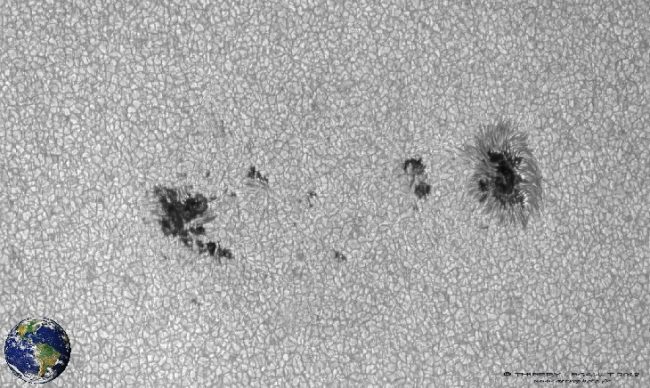 (Source: SpaceRef via Eric McFadden)
(Source: SpaceRef via Eric McFadden)
In direct contradiction to the official forecast, a team of scientists led by the National Center for Atmospheric Research (NCAR) is predicting that the Sunspot Cycle that started this fall could be one of the strongest since record-keeping began.
In a new article published in Solar Physics, the research team predicts that Sunspot Cycle 25 will peak with a maximum sunspot number somewhere between approximately 210 and 260, which would put the new cycle in the company of the top few ever observed.
The cycle that just ended, Sunspot Cycle 24, peaked with a sunspot number of 116, and the consensus forecast from a panel of experts convened by the National Aeronautics and Space Administration (NASA) and the National Oceanic and Atmospheric Administration (NOAA) is predicting that Sunspot Cycle 25 will be similarly weak. The panel predicts a peak sunspot number of 115.
If the new NCAR-led forecast is borne out, it would lend support to the research team’s unorthodox theory – detailed in a series of papers published over the last decade – that the Sun has overlapping 22-year magnetic cycles that interact to produce the well-known, approximately 11-year sunspot cycle as a byproduct. The 22-year cycles repeat like clockwork and could be a key to finally making accurate predictions of the timing and nature of sunspot cycles, as well as many of the effects they produce, according to the study’s authors.[…]

I hope this really does come to pass! I haven’t had any good DX at all here in South Florida.Besides that,I have limited antenna choices–being an apartment dweller. Last really good reception was in Gainesville, FL. I was enjoying Radio Guinea on a pretty regular basis in 2016 on 9650 Khz French with good African music.
I agree with the doubters above when you compare historical data from the Australian Bureau of Meteorology Space Weather Section of the “Weather Bureau”
https://www.sws.bom.gov.au/Solar/1/6
You might want to check the spelling of ‘CYLCE’ in the title – just a thought (heh)
Ugh! I’m on vacation and so is my brain right now! 🙂
For a fuller discussion of Scott McIntosh’s research team, hear my feature interview with him at https://www.icqpodcast.com/download-the-show/2020/8/30/icq-podcast-episode-332-exciting-bumper-new-solar-cycle.
73,
Frank
K4FMH
Six months ago “experts” were saying “It’s likely to be another uber low Maunder Minimum”.
Nobody knows.
There’s always DX
“Sunspot Cylce”, That’s a new one
Scott Martin, head of NCAR has preprints of solar cycle papers at
https://arxiv.org/a/mcintosh_s_1.html
well…
https://www.sciencealert.com/the-new-sunspot-cycle-could-be-one-of-the-strongest-we-ve-ever-recorded
good news, get your antennas ready 🙂
If the molasses-like minimum of cycle 24 has taught me on thing, then it’s “screw condx, it’s location and antenna that counts”. Of course that doesn’t account for radio blackouts et al but still, despite the almost record low SFI values and long spotless stretches I heard a lot of things I haven’t heard before and observed things I could never witness before.
So whatever group of scientists is seeing in their supercomputer-powered crystal balls, I’m fine with it. 🙂